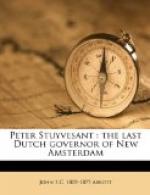Annihilation of the Esopus Tribe.—The Boundary Question.—Troubles on Long Island. The Dutch and English Villages.—Petition of the English.—Embarrassments of Governor Stuyvesant.—Embassage to Hartford.—The Repulse.—Peril of New Netherland.—Memorial to the Fatherland.—New Outbreak on Long Island.—John Scott and his High-handed Measures.—Strengthening the Fortifications.
All but three of the captives carried away by the Esopus Indians, were eventually recovered. The fate of those three is lost in hopeless obscurity. The revelations of the day of Judgment can alone make known their tragic doom. To them, as to thousands of others, this earthly life, if this be all, must have been an unmitigated calamity. But this is not all. After death cometh the judgment. It will be easy for God, in the future world, to compensate his children a thousand-fold for all the ills they are called to suffer in this life. There is true Christian philosophy in the beautiful poetry of Bryant,
“Oh, deem not they are blest alone
Whose lives an even
tenor keep.
For God, who pities man, hath shown
A blessing for the eyes that weep.
“For God has marked each sorrowing
day
And numbered every secret
tear,
And heaven’s long age of bliss
shall pay
For all his children
suffer here.”
Peace was now restored by the annihilation of the hostile Indians. Most of the Dutch soldiers returned to New Amsterdam. Still it was deemed important to enlarge and strengthen the fortifications at Esopus.
The boundary line between the British colonies in New England, and the Dutch settlements in New Netherland, still continued in dispute. The English, in numerical strength, were in the vast ascendency, and could easily overpower the Dutch. Very strenuous efforts had been made, by the States-General, to lead the British government to accept some boundary line. But all was in vain. It was very evident that the English intended to claim the whole. And it was also evident that their colonies were increasing so rapidly that, in a short time, they would be able to take possession of all the territory so strongly that it would be hopeless for the Dutch to attempt any resistance.
Governor Stuyvesant now received intelligence from Holland that there was no hope of any settlement being effected through the two governments, and that he must do everything in his power to strengthen the boundary lines the Dutch claimed, and to enter into such friendly relations with the New England colonists that they should not be tempted to undertake any encroachments. To add to the governor’s embarrassments very many Englishmen had taken up their residence in the Dutch settlements, particularly on Long Island. Though they had, of necessity, taken the oath of allegiance to the constituted authorities, their sympathies were with the New England colonists; and they would welcome any revolution which should transfer the territory to Great Britain, and thus absolve them from their oaths.




